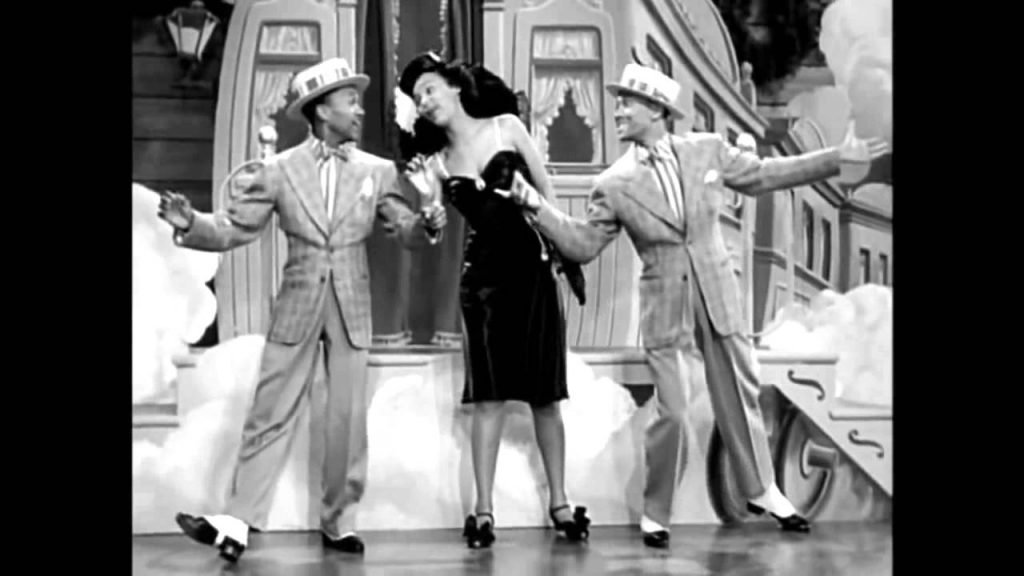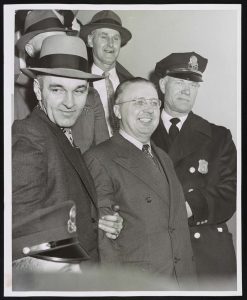It’s the evening of March 30, 1955. It’s the night of the 27th Academy Awards in Hollywood California. The celebrities are arriving in their limousines, and emerging from one of these, herded with blinding flashing lights, is a star. This star, from Cleveland, Ohio, is living out her dream. She has been nominated for the Best Actress award. Tonight, she’s making history. This woman is Dorothy Dandridge, and just for her being nominated, she is making history. Dorothy is the first African-American woman ever to be nominated for this award. And this nomination changed the way Americans thought, at least for that night. That Oscar would look so befitting in her hands. Her photo holding that Oscar from that night would be on every cover of every magazine in the country by the morning. Unfortunately, we never got to see that photo, because Dorothy did not win that night.

Dorothy Dandridge, born on November 9, 1922, first began her start in show business with her sister and another young woman in a musical trio. Once they gathered enough attention, they began performing at the Cotton Club during the 1930s.1 The famed Cotton Club was the dance club based in Harlem, New York where the most popular black singers and dancers performed, such as Cab Calloway and Duke Ellington, and it was where Dorothy Dandridge met her future husband. Here, Dorothy and her trio became so popular that they decided to take their show on tour to England. She finally married her husband, Harold Nicholas, of the Nicholas Brothers. The Nicholas Brothers were a duet who sang and tap danced together. Dorothy and Harold married on September 6, 1942. Dorothy’s marriage to Harold, however, was an unhealthy one, because her trio was receiving more fame than the Harold Brothers, causing tensions between them, and because Harold was also having affairs. But shortly after her marriage, Dorothy became pregnant and gave birth on September 2, 1943, and her baby girl was born brain damaged, due to a lack of oxygen. For the best for the child, Dorothy put her daughter in a private care agency. And after a number of years struggling with Harold and his infidelity, she finally divorced him in 1949.2
Determined to get back on her feet following the divorce, Dorothy decided to begin a solo career as a singer. It is as a singer that she gathered many fans and attention. But Dorothy always had a strong interest in acting. In 1948, when things in her marriage were rocky, she enrolled in The Actor’s Lab, which was the prestigious training school for actors in Los Angeles, California. During the 1940s, The Actor’s Lab trained many future Hollywood stars, including Marilyn Monroe. But during this period in cinematic history, it was hard for a black person to get leading roles on the big screen, especially roles that would change how black people were seen in society in general. In spite of her training at The Actor’s Lab, Dorothy would not get the opportunity to play black characters with strong, complex roles.3
As a black woman at this time in American history, if one wanted to act, one would not be given intelligent or self-respecting roles. The roles black women were given were highly stereotypical, but if acting was ones dream, as it was for Dorothy, she would take those stock roles anyway. After leaving The Actor’s Lab, Dorothy became one of those women who was offered those stock, degrading roles. Her first roles were those that had always been derogatory for black women, such as playing the role of a mistress.4 Such was the case in her films Tamango and Island in the Sun. Those roles were certainly easy for a black woman to portray. And Dorothy would receive roles like this until, finally, she landed a role alongside Harry Belafonte. Dorothy became the lead actress in the 1953 film Bright Road, in which she portrays a school teacher helping the principal, Harry Belafonte, tame their problem students. Her role in the film became a success, and it put Dorothy on the map, and brought her acclaim as an actress. But Dorothy wanted a bigger role. She sought out the lead role as Carmen in the 1954 film Carmen Jones. It was hard for black women to receive self-respecting roles in films, but ironically, in order to get such roles, one must first put on the act of not being self-respecting.5

At first, Dorothy was declined the role of Carmen Jones, and it was only after walking into the audition appearing promiscuous that she was given the role. Carmen Jones is a Broadway musical, but it was turned into a musical film starring an all-black cast, with the likes of Harry Belafonte and Pearl Bailey, and directed by Otto Preminger. Known for bringing any character she portrayed to life with her beauty, charisma, and flirtatious style, the role of Carmen Jones solidified Dorothy’s nomination. Shortly, after getting the role, she was put on the cover of Life Magazine in the same attire she auditioned in. Here Dorothy made history. Dorothy became the first African-American woman to grace the cover of Life. This role also got Dorothy Dandridge an Oscar nomination, becoming the first African-American woman nominated for the Best Actress Award. In 1955, it was hard for a black woman, or black man, to get the respect they deserved from the elite Academy of Motion Picture Arts and Sciences, much less be nominated for one of the most prestigious awards any actor can receive. This nomination was important not only for Dorothy, but for the millions of black men and boys, women and girls, who had the opportunity of watching history unfold, and being given a sense of hope and belief in themselves that they may not have had before those awards began.6
That night was important for America, for the black community, and for Dorothy, even though she did not win. She held her own going against some of the most iconic figures in film that night. The other nominees for the award were Judy Garland, Audrey Hepburn, Jane Wyman, and Grace Kelly. Grace Kelly was the winner of the award for her performance in The Country Girl.7

In Hollywood in 1955, Dorothy Dandridge was a double threat: she was a woman and she was black. Because of this, many opportunities passed her by. She was quoted as saying, “If I were Betty Grable, I could capture the world.” Betty Grable was an American singer, dancer, and actress prominent throughout the 1930s and 1940s. This much was true. Dorothy had much to offer, and it seems absurd today that such a minuscule thing such as race could keep someone from practicing their dream, but this is just what kept Dorothy and others’ dreams undermined. Unlike many, Dorothy Dandridge tackled this arbitrary system of discrimination head on, and she became a star. But she was not allowed to shine as brightly as many of her colleagues.8


After her nomination, Dorothy signed a contract with Twentieth Century Fox, entitling her to three more films. She was established as one of the biggest stars of the time. Unfortunately, Dorothy’s last role was in Preminger’s musical Porgy and Bess. On September 8, 1965 a star had truly fallen. Dorothy’s deceased body was found in her apartment. Decades later she would be reincarnated by Halle Berry in the film Introducing Dorothy Dandridge.9

Plagued by the segregation, sexism, and racism of the times, Dorothy Dandridge could not handle it and succumbed to demise. Hollywood throughout the forties and to the sixties reflected America and its racial tensions. Given the racial inequities of the era, Hollywood was not ready to have many leading roles for black women, and this showed through Dorothy’s career. Dorothy Dandridge inspired many, especially after her death. She broke many barriers for aspiring young black actors internationally. She had a dream, but because of her pigmentation, she was treated differently. Despite these odds, Dorothy was a still a formidable and respected actress. Dorothy was finally noticed as the prolific star she was, by being given an honorary star on the walk of fame on January 18, 1983, in Los Angeles, California.10
- African American Eras: Segregation to Civil Rights Times, 2011, s.v. “Dandridge, Dorothy” (1922–1965). ↵
- Rogers Patrick & Lyndon Stambler, “Overdue notice,” People 48, no. 4 (1997): 89. ↵
- Marguerite H. Rippy, “Exhuming Dorothy Dandridge: the black sex goddess and classic Hollywood cinema,” CineAction, no. 44 (1997): 21. ↵
- Louie Robinson, “The Private World of Dorothy Dandridge,” Ebony 17, no. 8 (1962): 116. ↵
- Cynthia Gorney, “The Fragile Flame of Dorothy Dandridge,” The Washington Post, February 09, 1988. ↵
- Walter Leavy, “The mystery and real-life tragedy of Dorothy Dandridge,” Ebony 49, no. 2 (December 1993): 36. ↵
- Robert K. Lightning, “Dorothy Dandridge: ruminations on black stardom,” CineAction, no. 44 (1997): 31. ↵
- Encyclopaedia Britannica, May 2017, s.v. “Dorothy Dandridge.” ↵
- Erin Anderson, “Dorothy Dandridge: Singer & Actress,” Booklist (2011), 71. ↵
- Ed Guerrero, “Dorothy Dandridge: A Biography,” Cineaste, Vol. 23 Issue 4 (1998): 60. ↵



85 comments
Michael Mandujano
The author produced a well-written article on Dorothy Dandridge. Prior to reading this article I had no idea who Dorothy Dandridge was. However, reading this article has allowed me to gain greater knowledge on Dandridge’s personal life and rise to fame. Overall, this was a well-structured article and I enjoyed the images throughout the article, especially the Youtube video that was included.
Clarissa Bustamante
This article was very well put together. I never had a clue as to who Dorothy Dandridge was before reading this. I was able to get a glimpse of the life Dandridge lived and visualize her talent by reading this article. The writer did such amazing job adding visuals and images throughout the article. I really believe that it helped the reader drastically get to imagine the type of person and the type of like Dorothy Dandridge was and lived.
Troy Leonard
this was a great article to read. the title is what caught my attention because she was a beautiful woman and I had never heard of Dorothy Dandridge before so I was really interested to find out who she was an what she was famous for. I’m glad that I did read this because she was very inspiring to the African American women that wanted to follow their dreams and act as well.
Joel Gracia
I always find articles like this to be extremely inspirational. I love to see people in the performing arts break barriers in the industry, because it makes me think of the doors that they opened for others down the road and how many careers they were in part responsible for. This article was satisfying in that it gave me a true idea of the talent that Dorothy possessed.
Cameron Ramirez
Dorothy Dandridge is someone who was such a fantastic star. I will have to admit I had no prior knowledge about Dorothy Dandridge. I had no clue who she was or what she did. But with your article that was so well put and the word flow made total sense. The videos you added peaked my interests I will have to admit I was tapping my foot on both videos. Anyways, good job on this article keep up the excellent work.
Samman Tyata
Great article! I really liked the way you have managed you article from start to the end. Honestly, I had no clue who Dorothy Dandridge was prior to reading this article. It was interesting to know that she was a highly talented woman who contributed a lot in the field of acting industry. To sum it up, i really loved reading your article. Good job!
Alejandra Chavez
I absolutely adored the intro to this article. At first I read it really simply like “oh it’s just going to be her winning this award” but when you said that she didn’t win it, it caught me off guard and truly made me interested in reading this article. It was a pleasant surprise, if you will. I admire how you mentioned the degrading roles she had to endure in order to get where she wanted to be. It really helped me and I’m sure, many other readers understand how much grit she had in order to do a treacherous job with a smile. I also admire how to progressively went from explaining how little people thought of her to how much she intimidated others by being a double threat. You were still able to shine light on all the other challenges she had yet to overcome but wasn’t able to in her time. This was a very well written article.
Deanna Lummus
This article was amazing! I thought it was very clear but also compelling! I have heard the name Dororthy Dandridge before but never knew her story. This article really shows her determination to do what she loves even when people continuously try to hold her back just because of the color of her skin and the fact that she was a women. Her impact on Hollywood and even the general public had to be great because now people like me who are unaware of her particular story is now reading about her by a fellow students’ article in 2017. Her giving women of color the chance to see a beautiful, successful, and respectful women living her dream is what I think is the biggest impact of her career on the general public.
Edward Cerna
Very interesting article to read and I really liked the pictures you used to go along with the text. The author did a wonderful job writing about Dandridge and she was really talented. I had never heard of her before until I read this article. I liked how she never gave up and pursued what she loved. Amazing article and good job.
Angela Rodriguez
Dorothy Dandridge is such an inspiring role model, who accomplished many things in life despite all the obstacles she faced during her lifetime. I am glad you, Aaiyanna Johnson choose to inform and educate others about an important influential person in history. I know that I had no prior knowledge about Dorothy Dandridge but I’m grateful you did, her legacy must continue to live on.